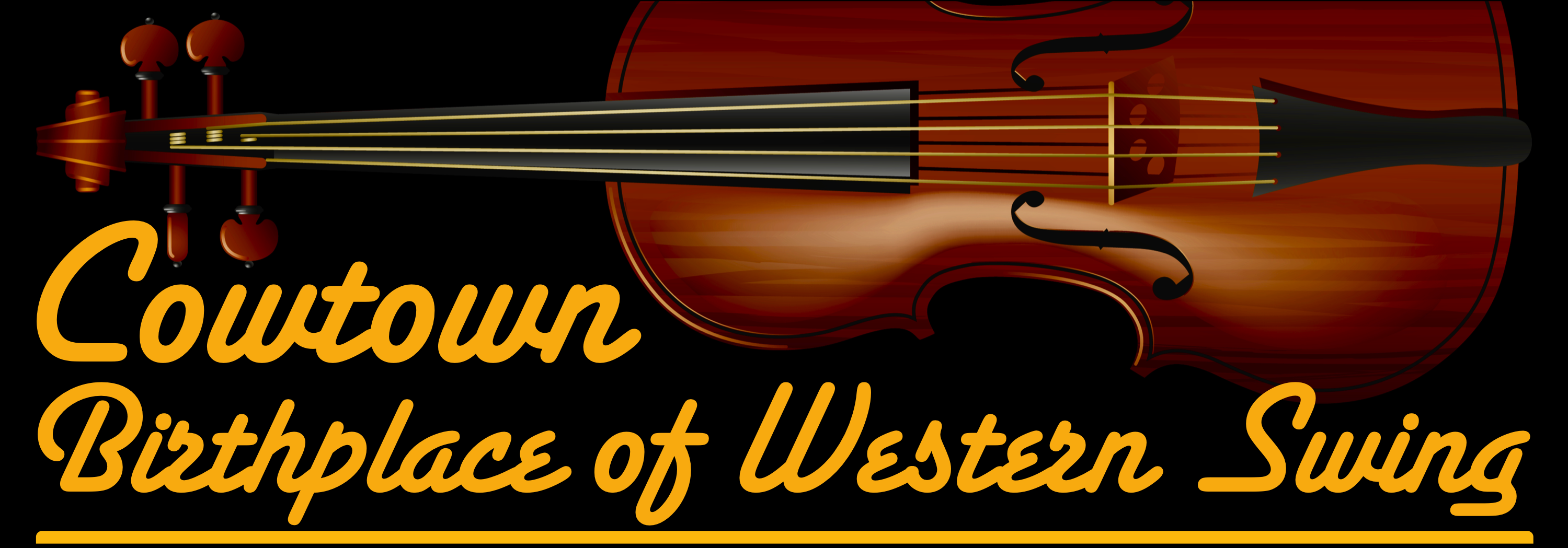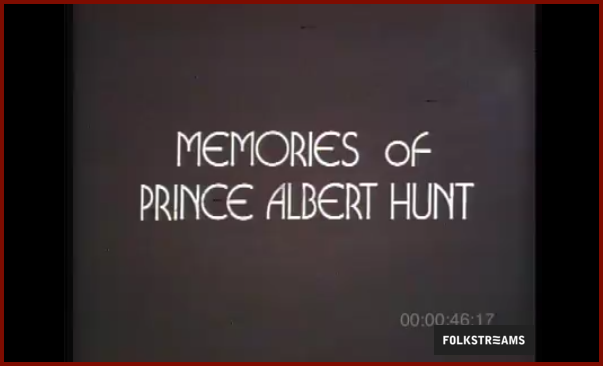Early Pioneers of Western Swing
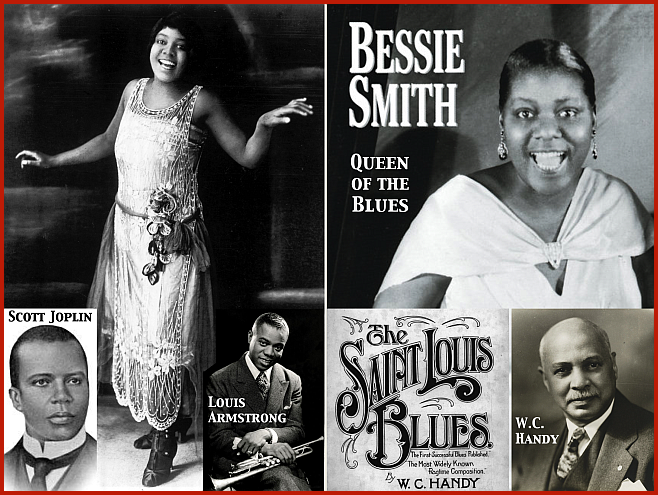
Western Swing has deep roots originating from 19th century European immigrant folk and polka music to significant African-American forms of music that rose across the south from Texas to Mississippi to Georgia. It is traced back to a number of genres from turn of the century Ragtime by East Texas composer and pianist Scott Joplin, to the "Father of Memphis Blues" W.C. Handy, to the 1920s New Orleans Jazz of Louis Armstrong, and the soulful vocals of the "Queen of the Blues" Bessie Smith. Bob Wills often told the story of how he rode 35 miles on horseback, from down between the rivers near Turkey to Childress, just to see Bessie Smith perform. Many years later he would tell Dr. Charles Townsend, "I believe Bessie was about the best I ever heard or seen." Milton Brown & his Musical Brownies' biggest dance hit was an up-tempo cover of Handy, Armstrong and Smith's greatest song, St. Louis Blues. Armstrong's influence cannot be understated. He, along with many talented artists like the great Vernon, Texas jazz trombonist Jack Teagarden, provided an enormous roadmap for early Texas and Mississippi Bluesmen, and helped evolve the contagious Big Band Swing dance music that swept major cities across America.
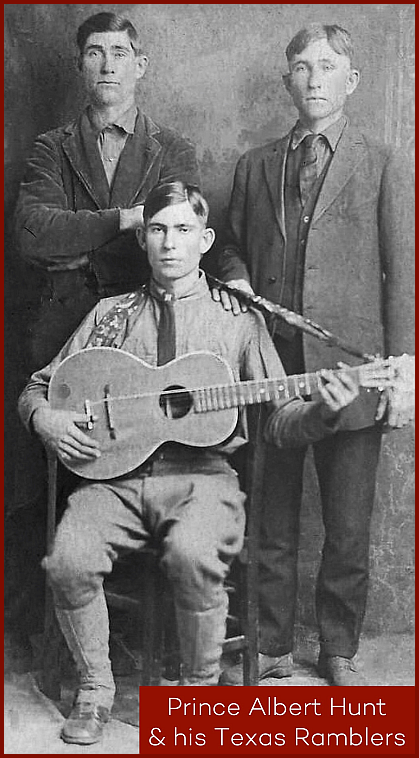 When the
relatively unknown East
Texas musician Prince Albert Hunt made his earliest recording of "Blues in the Bottle" and "Travelin' Man" in Fort Worth, Texas on
March 28, 1928, there was no such thing as Western Swing. Most historians agree it began in 1930 in Fort Worth as
a representation of Texas dance music based on two hot-string instruments: fiddle and guitar. It grew in sophistication all the way
through the 1940s with rich harmonized vocals, and more innovative, improvised and complex instrumentation.
When the
relatively unknown East
Texas musician Prince Albert Hunt made his earliest recording of "Blues in the Bottle" and "Travelin' Man" in Fort Worth, Texas on
March 28, 1928, there was no such thing as Western Swing. Most historians agree it began in 1930 in Fort Worth as
a representation of Texas dance music based on two hot-string instruments: fiddle and guitar. It grew in sophistication all the way
through the 1940s with rich harmonized vocals, and more innovative, improvised and complex instrumentation.
By World War II it had become one of the country's most popular musical styles, with major record companies already beginning to utilize the term "Texas Swing" for the first time in their catalogs. The term "Western Swing" was first used in 1944 by the radio announcer for Spade Cooley's more polished Venice, California big band.
By this time, the formative years of Western Swing were over, with dozens of bands recording hundreds of songs from coast to coast and heavily influencing Nashville country music, bee bop, rockabilly and eventually Rock & Roll. Despite its popularity and durability, the Texas born genre has since been one of the most under-represented and vastly ignored of the twentieth century, particularly as it relates to American life during the Great Depression, where it brought sheer enjoyment to loyal fans with its contagious dance beat.
Most fans consider the sole creator of Western Swing to be the legendary fiddler and bandleader Bob Wills. But this amalgamation of Frontier fiddle, Ragtime jazz, Plantation blues, German-Czech polka, Mexican mariachi and Cajun zydeco was actually born through a much more complicated process, and spearheaded by a variety of performers. The most notable of these was pop, jazz and blues singer Milton Brown, who together with Wills, formed the first fusion of fiddle, guitar and vocal jazz with the 1930 birth of their Light Crust Doughboys band in Fort Worth. Brown left the Doughboys in 1932 and assembled the prototype for what subsequent bands would be measured against: Milton Brown & his Musical Brownies.
Although Brown can be given credit for having the first Western Swing band, even he wasn't the first to combine black and white race music in the Southwest. The aforementioned Prince Albert Hunt from Terrell, Texas played scraping blues influenced by the race music he learned from his white parents, and mainly from listening to the tawdry black bluesmen singers and guitarists he heard in the early 1920s on the streets and saloons of Dallas' "Deep Ellum," the city's notorious red light district. Like Bob Wills, Hunt also gained blues influence working as a black-face musician in a traveling minstrel show. While some might disagree with Hunt's founding contribution, it is important to identify him and his Texas Ramblers band as a distinct resemblance to Western Swing. Hunt's growling, bluesy vocals, hard-pounding string rhythm and hints of jazz fiddle certainly signaled things to come.
 Not far from
Hunt's home of Terrell, another early influence came in the late 1920s from Lindale, Texas. The East Texas Serenaders
with their designated frontman and songwriter, left-handed Texas Champion double-shuffle fiddler Daniel Huggins Williams, were a
strong influence on Western Swing. As opposed to Hunt's blues style, they had an an up-beat instrumental repertoire that swayed
toward ragtime, swing jazz and waltz. The Serenaders' sound was described as a step toward mixing swing with string-band music, a
clear departure from hillbilly and folk-band tradition. Williams' rhythm guitarist (Cloet Hamman), cello player (Henry Bogan), and
banjoist (John Munnerlyn) made one of the most forceful rhythm sections in string band history. In addition to the group's
progressive arrangements, they also incorporated jazz and cajun influences they encountered while listening to Louisiana radio
programming. The Serenaders December 2, 1927 recording of "Combination Rag" and "Sweetest Flower Rag" showed off Williams' tour
de force double-shuffle technique, where he accumulated more notes per bar than any fiddler of his era was capable of playing. Many
years later, Williams' fine fiddle talent would tutor the legendary fiddler Johnny Gimble.
Not far from
Hunt's home of Terrell, another early influence came in the late 1920s from Lindale, Texas. The East Texas Serenaders
with their designated frontman and songwriter, left-handed Texas Champion double-shuffle fiddler Daniel Huggins Williams, were a
strong influence on Western Swing. As opposed to Hunt's blues style, they had an an up-beat instrumental repertoire that swayed
toward ragtime, swing jazz and waltz. The Serenaders' sound was described as a step toward mixing swing with string-band music, a
clear departure from hillbilly and folk-band tradition. Williams' rhythm guitarist (Cloet Hamman), cello player (Henry Bogan), and
banjoist (John Munnerlyn) made one of the most forceful rhythm sections in string band history. In addition to the group's
progressive arrangements, they also incorporated jazz and cajun influences they encountered while listening to Louisiana radio
programming. The Serenaders December 2, 1927 recording of "Combination Rag" and "Sweetest Flower Rag" showed off Williams' tour
de force double-shuffle technique, where he accumulated more notes per bar than any fiddler of his era was capable of playing. Many
years later, Williams' fine fiddle talent would tutor the legendary fiddler Johnny Gimble.
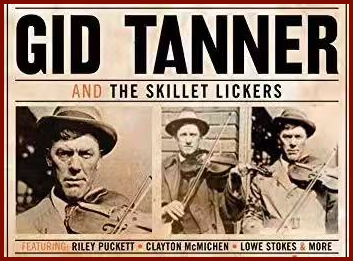
 Hunt and Williams' 1920s bands helped influence
traditional Texas string bands to transform and develop into what would later become
Texas Swing. Other influences include an early variation of string instrument blues called "Hokum". One of the pioneering Hokum groups in
Texas was the Dallas String Band, featuring Coley Jones on mandolin. Their December 8, 1928 recording of Hokum Blues at Fort Worth's Baker
Hotel was a pioneering fusion of proto bluesman meets Texas country. They were likely to have attracted both black and white audiences in
Fort Worth's Hell's Half Acre and Dallas' Deep Ellum live music bordello districts. The great bluesmen Blind Lemon Jefferson and T-Bone
Walker played in the Dallas String Band at various times during the late 1920s at several Hell's Half Acre and Deep Ellum bordello night
clubs. Milton Brown's very first 1933 recording with his Musical Brownies was a Hokum tune with scat lyrics, "Garbage Man Blues". Bob
Wills, who had performed in blackface minstrel shows in Fort Worth as early as 1928, learned from this bawdy Hokum style, liberally using
his jig dance, comic asides, whoops, hollers and jive talk when directing his Light Crust Doughboys and Texas Playboys.
Hunt and Williams' 1920s bands helped influence
traditional Texas string bands to transform and develop into what would later become
Texas Swing. Other influences include an early variation of string instrument blues called "Hokum". One of the pioneering Hokum groups in
Texas was the Dallas String Band, featuring Coley Jones on mandolin. Their December 8, 1928 recording of Hokum Blues at Fort Worth's Baker
Hotel was a pioneering fusion of proto bluesman meets Texas country. They were likely to have attracted both black and white audiences in
Fort Worth's Hell's Half Acre and Dallas' Deep Ellum live music bordello districts. The great bluesmen Blind Lemon Jefferson and T-Bone
Walker played in the Dallas String Band at various times during the late 1920s at several Hell's Half Acre and Deep Ellum bordello night
clubs. Milton Brown's very first 1933 recording with his Musical Brownies was a Hokum tune with scat lyrics, "Garbage Man Blues". Bob
Wills, who had performed in blackface minstrel shows in Fort Worth as early as 1928, learned from this bawdy Hokum style, liberally using
his jig dance, comic asides, whoops, hollers and jive talk when directing his Light Crust Doughboys and Texas Playboys.
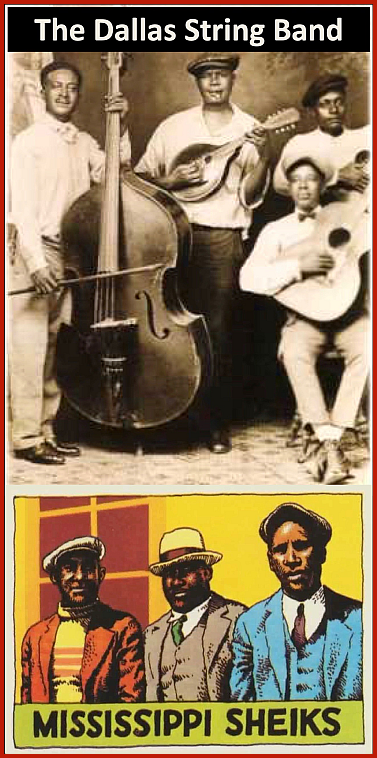 After the first World War,
the fledgling record industry split Hokum off from its minstrel show context to market itself as a musical
genre. Early practitioners surfaced in black jug bands performing in the saloons and bordellos on Beale Street in Memphis and eventually
spreading to Texas and many cities throughout the South. Hokum for the white adaptors of this genre in the South and Southwest was synonymous
with jazz, and the "hot" syncopations and blues notes were a naughty pleasure in themselves. The pioneering lap steel guitarist Cliff Carlisle
is credited with refining Hokum and further developing the blue yodel singing style of Jimmie Rodgers. He wrote and recorded many Hokum tunes
and marketed himself as a Hillbilly, Cowboy, Hawaiian or Bluesman, depending on the audience for whom he was playing. Texas Playboy Tommy
Duncan was heavily inspired by Carlisle's singing style.
After the first World War,
the fledgling record industry split Hokum off from its minstrel show context to market itself as a musical
genre. Early practitioners surfaced in black jug bands performing in the saloons and bordellos on Beale Street in Memphis and eventually
spreading to Texas and many cities throughout the South. Hokum for the white adaptors of this genre in the South and Southwest was synonymous
with jazz, and the "hot" syncopations and blues notes were a naughty pleasure in themselves. The pioneering lap steel guitarist Cliff Carlisle
is credited with refining Hokum and further developing the blue yodel singing style of Jimmie Rodgers. He wrote and recorded many Hokum tunes
and marketed himself as a Hillbilly, Cowboy, Hawaiian or Bluesman, depending on the audience for whom he was playing. Texas Playboy Tommy
Duncan was heavily inspired by Carlisle's singing style.
Other significant contributions that inspired Milton Brown and Bob Wills came from the great Delta Country Blues string band - The Mississippi Sheiks - with their huge 1930 hit "Sittiin' On Top Of The World", along with the hot string hokum Georgia Wildcats featuring Clayton McMichen and his hit song "Wildcat Rag", as well as several south Texas German and Czech immigrant polka-waltz-schottische bands who played in the numerous historic German dancehalls of South Texas and the Mexican Mariachi "Jalisco" bands who performed in plazas and restaurants throughout the Southwest. The rowdy Georgia hillbilly band - Gid Tanner & his Skillet Lickers - was an up-tempo hillbilly hokum string band that heavily influenced Wills and Brown. And lest we forget the influence of comedic black face minstrel performer, Emmett Miller & his Georgia Crackers. Wills modeled his joyful minstrel singing & dancing style and wisecrack side-talking after Miller.
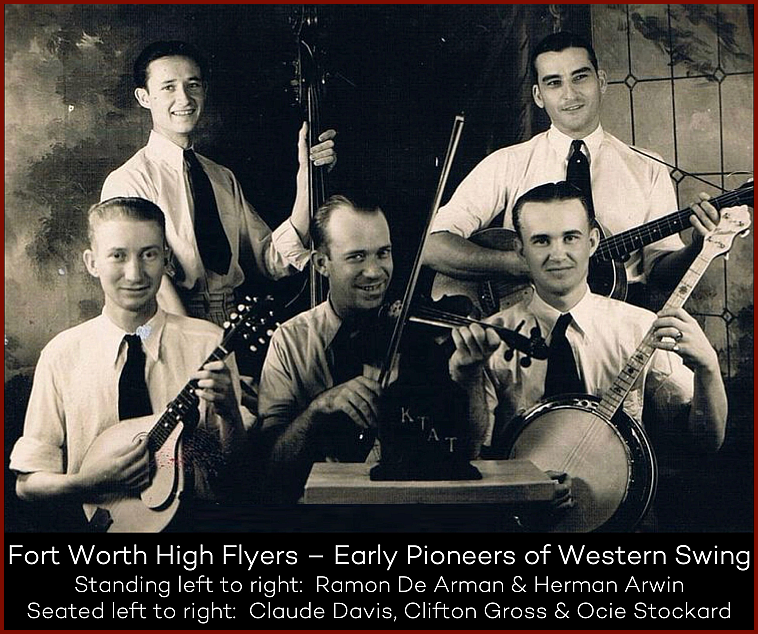 The Fort Worth High Flyers were another
significant string band who are regarded as a pioneering early influence to Western Swing. They were organized in 1929 and promoted by radio
personality Zack Hurt on KFJZ. Fiddler Clifford Gross, guitarist Herman Arwine, banjoist Ocie Stockard, and Claude Davis on mandolin
were among the original lineup that played a repertoire that included primarily waltzes, breakdowns, and pop selections. The band had
its own radio program on KFJZ from 1929 to 1937 and played at dances in the Fort Worth area, particularly at legendary Crystal Springs
Dancehall. The High Flyers were one of the earliest string bands in Texas that incorporated jazz improvisations into its performances.
The band changed it's name to the Hi-Flyers by 1932, and guitarist Elmer Scarborough established himself as the leader. Later that same
year, Ocie Stockard left the band to join Milton Brown & his Musical Brownies. Al Stricklin was with the band for a brief time in 1935
before he joined Bob Wills & his Texas Playboys in Tulsa. Clifford Gross left the band in 1936 to join the famed Light Crust Doughboys.
In 1937 the Hi-Flyers recorded for Vocalion in Dallas. They cut a total of nineteen songs in two sessions. Those sessions included newer
members Billy Briggs on steel guitar, Darrell Kirkpatrick on fiddle and Landon Beaver on jazz piano. The group moved to the Mexican border
in 1937 to Del Rio, Texas where they played on Mexico's powerful 1 million watt XEPN radio, broadcasting to most of North America. They
then moved to Oklahoma City in 1939 to perform on KOMA radio. From 1939 to 1941 the Hi-Flyers made more recordings that reflected Western
Swing influences, along with honky-tonk themes. They disbanded in 1946 when World War II had taken most of the band members to the military.
The Fort Worth High Flyers were another
significant string band who are regarded as a pioneering early influence to Western Swing. They were organized in 1929 and promoted by radio
personality Zack Hurt on KFJZ. Fiddler Clifford Gross, guitarist Herman Arwine, banjoist Ocie Stockard, and Claude Davis on mandolin
were among the original lineup that played a repertoire that included primarily waltzes, breakdowns, and pop selections. The band had
its own radio program on KFJZ from 1929 to 1937 and played at dances in the Fort Worth area, particularly at legendary Crystal Springs
Dancehall. The High Flyers were one of the earliest string bands in Texas that incorporated jazz improvisations into its performances.
The band changed it's name to the Hi-Flyers by 1932, and guitarist Elmer Scarborough established himself as the leader. Later that same
year, Ocie Stockard left the band to join Milton Brown & his Musical Brownies. Al Stricklin was with the band for a brief time in 1935
before he joined Bob Wills & his Texas Playboys in Tulsa. Clifford Gross left the band in 1936 to join the famed Light Crust Doughboys.
In 1937 the Hi-Flyers recorded for Vocalion in Dallas. They cut a total of nineteen songs in two sessions. Those sessions included newer
members Billy Briggs on steel guitar, Darrell Kirkpatrick on fiddle and Landon Beaver on jazz piano. The group moved to the Mexican border
in 1937 to Del Rio, Texas where they played on Mexico's powerful 1 million watt XEPN radio, broadcasting to most of North America. They
then moved to Oklahoma City in 1939 to perform on KOMA radio. From 1939 to 1941 the Hi-Flyers made more recordings that reflected Western
Swing influences, along with honky-tonk themes. They disbanded in 1946 when World War II had taken most of the band members to the military.
Another influence that helped shape the early days of Western Swing and attract fans from across the country were Hollywood's "Singing Cowboys". They were created as a subtype of the archetypal Cowboy hero of early Western films, popularized by many of the B-movies of the 1930s and 1940s. The typical singing cowboys were white-hat-wearing, clean-shaven heroes with a habit of showing their emotions in song. Around the campfire, these lonesome cowboys sang of life on the trail with all the challenges, hardships, and dangers encountered while pushing cattle for miles up the trails and across the prairies.
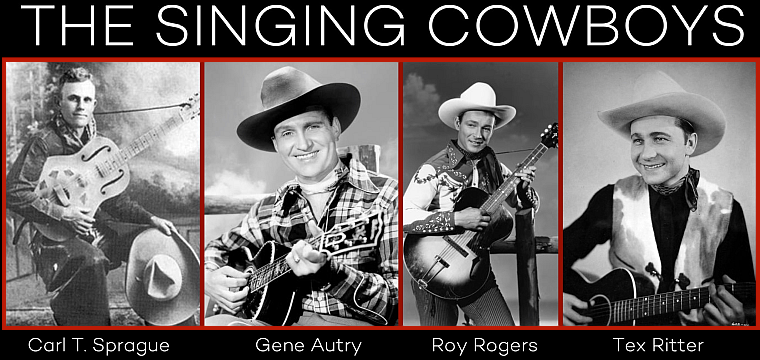
While much of what is included in the genre of "cowboy music" is "traditional", a number of songs were written and made famous by the early singing cowboy groups Sons of the Pioneers and Riders in the Sky, and the famous individual performers like Gene Autry, Roy Rogers, Tex Ritter, Ken Curtis, Jimmy Wakely and a number of others. Singing in their Texas ranch wrangling style, these entertainers have served to preserve the cowboy as a unique American Hero.
The image of the singing cowboy was established in 1925 when authentic Texas cowboy Carl T. "Doc" Sprague recorded the very first cowboy song, "When the Work's All Done This Fall", about a cowboy killed during a night stampede. One year later he recorded the great cowboy ballad "O Bury Me Not On The Lone Prairie". Sprague learned the songs from his uncle who fondly remembered the cowboy poems and ballads from trail drives during his working cowboy days of the late 1880s. Sprague's renditions are a direct link to a time when the poems and ballads, some of them centuries old, were first sung by the drovers who moved the great Longhorn cattle herds out of south and west Texas to the rail heads of Fort Worth, Kansas City and beyond.

America's fascination with the cowboy began sometime after the Civil War and by the 1880s vaudeville troupes like Buffalo Bill's Wild West Show were at the height of their popularity. In 1883 Buffalo Bill's Cowboy Band was organized and directed by William Sweeney. A cornet player, Sweeney was the leader of the Cowboy Band from 1883 until 1913. This band and later Billy McGinty's troupe and Otto Gray & his Oklahoma Cowboy Band (1918) paved the way for Western and Hillbilly string bands, singing cowboys and eventually the frontier fiddle meets jazz fusion sounds of Western Swing that would emerge in Fort Worth, Texas in the early 1930s.
From the very beginning, Western Swing was like a ravenous animal, devouring everything in its path. It started with two instruments, a fiddle and guitar, that were played at small neighborhood house dances. Vocalists, in the form of square dance callers, were soon added to enhance the dancers' entertainment. When the music eventually moved from Texas ranches and small towns to the larger cities of Fort Worth and Dallas, the singing and instrumentation became more sophisticated as the repertoire expanded to include popular songs and Tin Pan Alley numbers.
The venues changed as well, as ranch and house dances gave way to community facilities, dance pavilions - like Fort Worth's legendary Crystal Springs, lodges, high schools and eventually large dance halls and ballrooms. As the crowds grew, so did the bands. Other louder instruments were added, including the tenor banjo and mandolin, followed by the booming bass fiddle, which further enhanced the dance beat.
 By this time it was 1932 and the
Father of Western swing, Milton Brown, had formed his innovative Musical Brownies. Brown
made further additions to his band, including a pulsating ragtime piano, played by the Earl Hines-influenced Fred "Papa" Calhoun.
Brown also instructed his bass player, Wanna Coffman, to slap his instrument rather than bowing or plucking it in order to further
the pounding rhythm needed for dancing. He added harmonizing twin fiddles which provided both fast-paced double-shuffle breakdowns
from his classically trained fiddler
By this time it was 1932 and the
Father of Western swing, Milton Brown, had formed his innovative Musical Brownies. Brown
made further additions to his band, including a pulsating ragtime piano, played by the Earl Hines-influenced Fred "Papa" Calhoun.
Brown also instructed his bass player, Wanna Coffman, to slap his instrument rather than bowing or plucking it in order to further
the pounding rhythm needed for dancing. He added harmonizing twin fiddles which provided both fast-paced double-shuffle breakdowns
from his classically trained fiddler  Cecil
Brower, and smooth improvised runs from his Joe Venuti-influenced jazz fiddler Jesse
Ashlock. Ashlock left the Brownies in 1933 to join Bob Wills newly formed Texas Playboys band, and Brown then hired the great
Cajun-inspired jazz fiddler Cliff Bruner. Finally, Brown added his greatest innovation - the saxophone-inspired Bob Dunn with
his piercing horn-like steel guitar, the very first electrically amplified instrument in music history!
Cecil
Brower, and smooth improvised runs from his Joe Venuti-influenced jazz fiddler Jesse
Ashlock. Ashlock left the Brownies in 1933 to join Bob Wills newly formed Texas Playboys band, and Brown then hired the great
Cajun-inspired jazz fiddler Cliff Bruner. Finally, Brown added his greatest innovation - the saxophone-inspired Bob Dunn with
his piercing horn-like steel guitar, the very first electrically amplified instrument in music history!
By the time Milton Brown was tragically killed in an automobile accident in April of 1936, the die was cast. Bands had sprung up though out the state of Texas and beyond, most modeling themselves after the Musical Brownies like Bill Boyd, Roy Newman, Jimmie Revard, Adolf Hofner, Cliff Bruner, Leon Chappelear and others. The innovation and development exploded with Brown's co-founder of Texas Swing, the legendary King of Western Swing Bob Wills, who attracted the finest musicians to his Texas Playboys band, reaching national stardom from Hollywood to Nashville.
